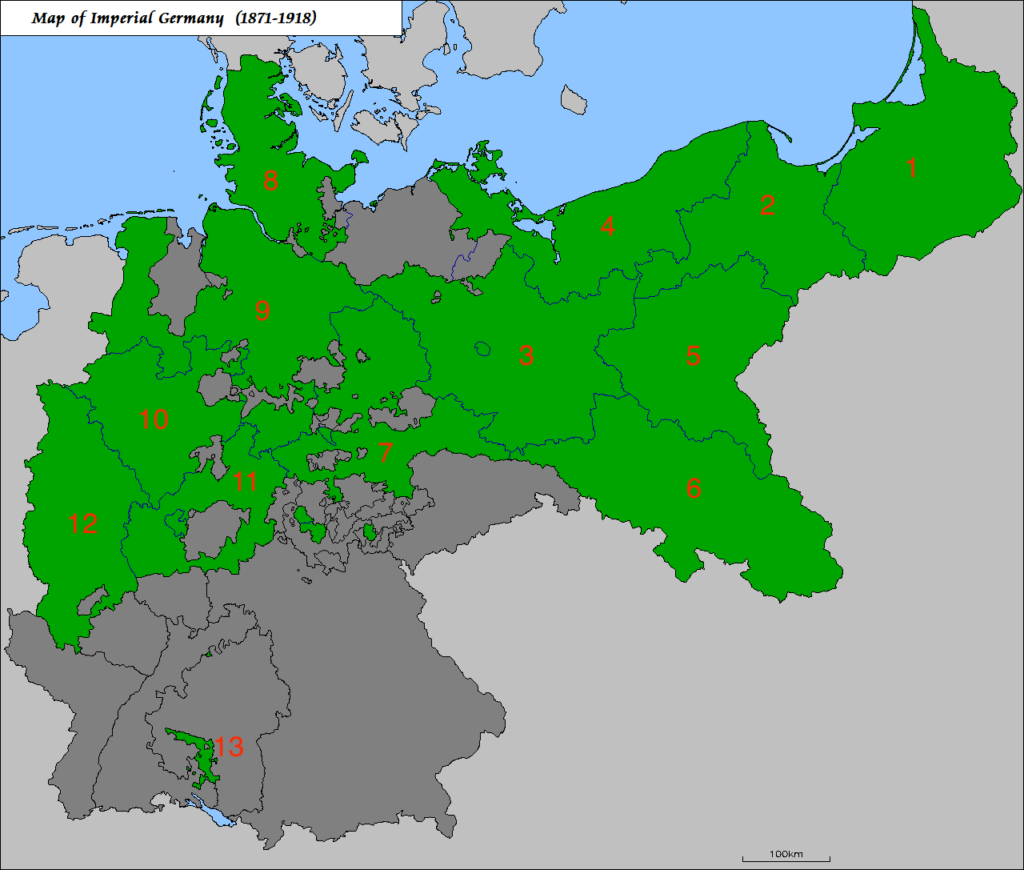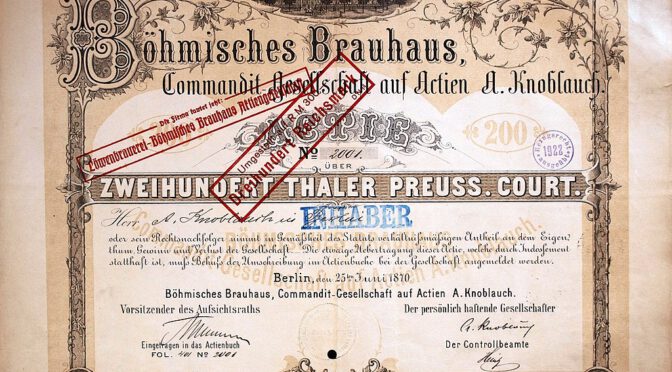In my recent article about top- vs bottom-fermenting breweries in Germany 1889/1890, I simplified one bit of the data: I lumped together all provinces of Prussia, when the data was actually much more detailed specifically for that state.
So let’s start with the per-province data:
| Breweries | Production volume [hl] | ||||
| No. | Province | TF | BF | TF | BF |
| 1 | East Prussia | 199 | 52 | 328,721 | 582,580 |
| 2 | West Prussia | 42 | 60 | 172,278 | 419,883 |
| 3 | Brandenburg | 444 | 125 | 1,839,780 | 2,876,476 |
| 4 | Pomerania | 235 | 82 | 126,654 | 531,615 |
| 5 | Posen | 113 | 51 | 218,544 | 270,509 |
| 6 | Silesia | 654 | 199 | 1,128,173 | 1,534,086 |
| 7 | Saxony | 465 | 174 | 646,987 | 1,791,947 |
| 8 | Schleswig-Holstein | 653 | 53 | 282,954 | 952,226 |
| 9 | Hanover | 355 | 110 | 155,436 | 1,001,521 |
| 10 | Westphalia | 468 | 248 | 101,883 | 2,000,935 |
| 11 | Hesse-Nassau | 90 | 312 | 28,404 | 1,613,806 |
| 12 | Rhineland | 783 | 371 | 1,030,283 | 2,527,309 |
| 13 | Hohenzollern | 93 | 146 | 4,659 | 117,557 |
I added numbers to give you a better idea where each of these provinces were located using this map:

Now let’s again look at the ratio of bottom- to top-fermenting breweries per province:
| No. | Region | BF / TF |
| 1 | East Prussia | 0.26 |
| 2 | West Prussia | 1.43 |
| 3 | Brandenburg | 0.28 |
| 4 | Pomerania | 0.35 |
| 5 | Posen | 0.45 |
| 6 | Silesia | 0.30 |
| 7 | Saxony | 0.37 |
| 8 | Schleswig-Holstein | 0.08 |
| 9 | Hanover | 0.31 |
| 10 | Westphalia | 0.53 |
| 11 | Hesse-Nassau | 3.47 |
| 12 | Rhineland | 0.47 |
| 13 | Hohenzollern | 1.57 |
The first thing I noticed is that there are only three provinces with more bottom-fermenting than top-fermenting breweries: West Prussia, Hesse-Nassau and Hohenzollern. When you look at the raw data, West Prussia in general didn’t seem to have too many breweries in the first place. Hesse-Nassau, just like the State of Hesse (which it fully surrounds), also seems to have switched over to bottom fermentation, but not quite to the extent as Hesse. And then there’s Hohenzollern, which is actually quite separate from the rest of Prussia and located very much in the South of Germany where bottom fermentation has a more longstanding tradition.
This brings me to the next table of statistics, the average production volumes per province, divided between top- and bottom-fermenting breweries:
| hl / Brewery | ||||
| No. | Region | TF | BF | BF / TF |
| 1 | East Prussia | 1,651.86 | 11,203.46 | 6.78 |
| 2 | West Prussia | 4,101.86 | 6,998.05 | 1.71 |
| 3 | Brandenburg | 4,143.65 | 23,011.81 | 5.55 |
| 4 | Pomerania | 538.95 | 6,483.11 | 12.03 |
| 5 | Posen | 1,934.02 | 5,304.10 | 2.74 |
| 6 | Silesia | 1,725.04 | 7,708.97 | 4.47 |
| 7 | Saxony | 1,391.37 | 10,298.55 | 7.40 |
| 8 | Schleswig-Holstein | 433.31 | 17,966.53 | 41.46 |
| 9 | Hanover | 437.85 | 9,104.74 | 20.79 |
| 10 | Westphalia | 217.70 | 8,068.29 | 37.06 |
| 11 | Hesse-Nassau | 315.60 | 5,172.46 | 16.39 |
| 12 | Rhineland | 1,315.81 | 6,812.15 | 5.18 |
| 13 | Hohenzollern | 50.10 | 805.18 | 16.07 |
Hohenzollern absolutely stands out here, with just tiny average production volumes. Whatever top-fermenting breweries existed there, they must have been pretty small in operation (at least on average), some of them probably glorified home-brewing operations. But even the bottom-fermenting breweries were really small compared to all the other provinces.
The brewery structure of Hohenzollern (but this is just an educated guess) was probably closer to regions like Franconia, where a lot of small, local breweries were established and just served a very local market, with relatively little industrialisation at the time.
Brandenburg (which includes Berlin) seems to have been the exact opposite, not only because it had a fairly strong top-fermenting brewing industry with a pretty large number of breweries and strong average production volumes, but also had by far the largest production volumes for bottom-fermenting breweries. These number probably mostly reflect the Berlin brewing industry: a large number of breweries making Berliner Weisse and other top-fermented beers for a market that is strong but slowly declining on the one hand, and large, industrial breweries specifically founded and built for brewing fashionable bottom-fermented beers on the other hand.
Interestingly, the Rhineland, nowadays very well known for its hyperlocal top-fermented beer cultures of Kölsch (in Cologne and surrounding areas) and Altbier (in Düsseldorf and the Lower Rhine region), does not particularly stand out as much as I would have expected. While it is the province with the third-largest total production volume of top-fermented beers in Prussia, when ranked by average production volume per brewery, it can only be found on seventh place. When looking at total bottom-fermented volume, the Rhineland is even number 2 of all provinces, but at the same time also has by far the largest number of bottom-fermenting breweries, which brings down the average production volume a lot.
It does show though that in the Rhineland, beer was an important product with presumably one of the highest per-capita consumption in all of Prussia. At least the large number of breweries would suggest a focus on the local market and a comparatively less consolidated beer market overall.


One thought on “Top- vs. Bottom-Fermenting Breweries in Prussia 1889/1890”